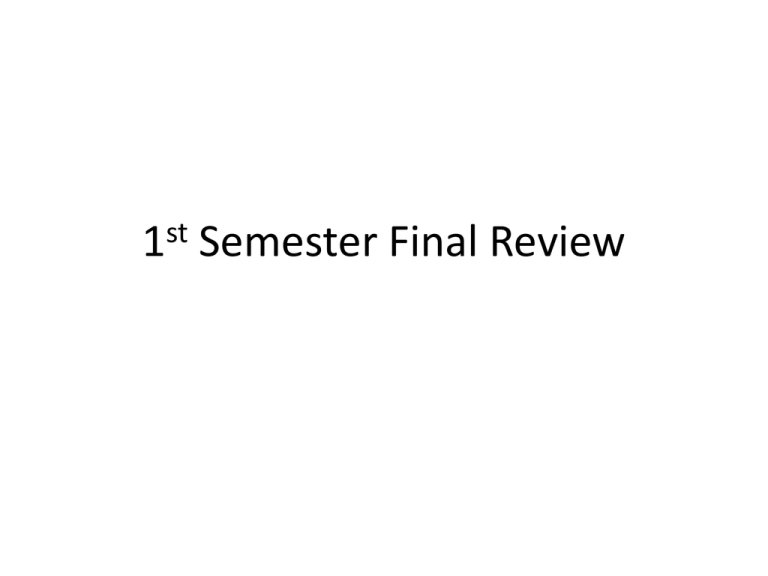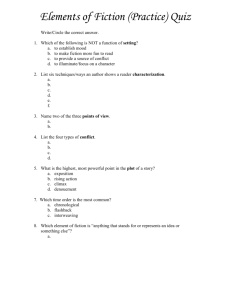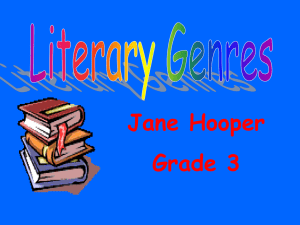1st Semester Final Review
advertisement

st 1 Semester Final Review Facts or Opinion Facts are statements that can be proven. Facts may be true or false. But facts can be proven. Opinions are statements that cannot be proven. Opinions can be argued. Opinions may be supported with facts. Opinions cannot be proven. Opinion or Fact Examples 1. 2. 3. 4. 5. 6. Golf is boring. Statistically, women live longer than men. Most buses weigh more than most cars. Pizza is delicious. There are ten inches in a foot (false). Math is the hardest subject. Antonyms or Synonyms • Anti – means against or opposite • Syn – means same • Onym – means name or word • Antonym means a word with the opposite meaning • Synonym means a word with the same meaning What are the following pairs of words: • • • • • • Under ~ Over Exit ~ Leave Produce ~ Make Fiction ~ Made up or Fake Sequence ~ steps Love ~ Hate Plot Structure Components Climax: The turning point. The most intense moment (either mentally or in action.) Rising Action: the series of conflicts and crisis in the story that lead to the climax. Falling Action: all of the action which follows the Climax. Exposition: the main character & setting [time and place] are given. Also, the background information that is needed to understand the story and the conflict may be introduced. Resolution: The conclusion, the tying together of all of the threads. Expositions • Exposition: The mood and conditions existing at the beginning of the story. The setting is identified. The main characters with their positions, circumstances and relationships to one another are established. The exciting force or initial conflict is introduced. Sometimes called the “Narrative HOOK” this begins the conflict that continues throughout the story. • Rising Action: The series of events, conflicts, and crises in the story that lead up to the climax, providing the progressive intensity, and complicate the conflict. • Climax: The turning point of the story. A crucial event takes place and from this point forward, the protagonist moves toward his inevitable end. The event may be either an action or a mental decision that the protagonist makes. • Falling Action/Denouement: The events occurring from the time of the climax to the end of the story. The main character may encounter more conflicts in this part of the story, but the end is inevitable. • Resolution: The tying up of loose ends and all of the threads in the story. The conclusion. The hero character either emerges triumphant or is defeated at this point. Chronological In order of time Chrono = time Stories are told chronologically Moved Away Met Girl Fell in Love Born Married Died in 1882 in 1906 in 1948 Sequence / Order of Importance Steps described in the order they occur. Get bread Tighten Laces Tie Loops Together Make Two Loops Put on Shoe Open jars Spread peanut butter Spread jelly Combine slices Enjoy. Does not take place at any specific point in time. Cause and Effect Explains reasons why something happened. Or explains the effects of something. Many Karate Schools Opened. Not feeding it. Not petting it. Why Dog Ran Away Lots of Karate Movies in 60’s Nun chuck sales Increased 400% Not loving it. Hospital cases went up. Problem and Solution Author states a problem and solution(s). Similar to cause and effect. Missing Books Eagles were endangered. Putting in the Closet Getting Lockers Make laws to protect them. Basically Cause & Effect With an Opinion. And an answer. Compare and Contrast Compare = find similarities Contrast = find differences Shows what’s in common and what’s different. Apples & Oranges Fruits Colors Have Seeds Tastes Healthy Locations Spatial or Descriptive Describes a place or thing or other noun usually utilizing prepositional phrases In the center of the Field is a water trough for the horses Around the perimeter is a wooden fence In the far corner is a red metal gate Fiction Nonfiction Folklore Drama Fairy Tale Historical Fiction Informational Writing Fantasy Realistic Fiction Persuasive Writing Autobiography Biography Comedy Tragedy Fable Science Fiction Poetry Myth Legend Tall Tale 5 Main Genres 1. Fiction: imaginative or made up writing, Fake 2. Nonfiction: writing that is true, NOT FAKE 3. Folklore: stories once passed down orally from generation to generation. Usually has an “unknown” author or will be “retold” or “adapted” by the author. 4. Drama: a play or script 5. Poetry: writing concerned with the beauty of language Fiction Genre FICTION SUBGENRES • Historical Fiction: a STORY based on or around a person or event from history. -HISTORY BASED, BUT IT NEVER REALLY TOOK PLACE • Science Fiction: has aliens, robots, futuristic technology and/or space ships • Fantasy: a story that has monsters, magic, or characters with superpowers… ex: Shrek (in years to come it could become a Fiction-fantasy story and a TRUE folklore- fairytale • Realistic Fiction: a story that sounds real but it never really took place. Nonfiction Genre Nonfiction Subgenres • Informational Writing: explains something, cook book, pamphlet, instructions, newspaper article • Persuasive Writing: tries to influence the reader, SPEECH, advertisement • Autobiography: the life story written and told by oneself. • Biography: the life story of someone told by someone else Auto = Self Latin Roots Bio = Life Graphy = Writing Folklore Genre Folklore/Folktales genres Fairytale: has magic and/or talking animals. • Often begins with “Once upon a time…” ends with “They lived happily ever after…” • Often has a human main character – Snow White and the Seven Dwarfs – Cinderella THINK DISNEY! Fable: short story with personified (TALKING) animals and a moral (LESSON LEARNED) ex: Goldilocks and the Three Bears, Little Red Riding Hood, Tortoise and the Hare, The Boy Who Cried Wolf Goldilocks and the Three Bears- Disney http://www.youtube.com/watch?v=atipwymJk5I The Three Little Pigs -Disney http://www.youtube.com/watch?v=Olo923T2HQ4 Little Red Riding Hood and the Three Little Pigs -Disney http://www.youtube.com/watch?v=c78fBl41OLc The Three Little Pigs- The Muppets http://www.youtube.com/watch?v=osBpB2lUL2w Myth: has gods/goddesses and usually accounts for the creation of something, Greek Mythology ex:Native American literature, ex: Greek and Roman: Perseus, Medusa, Pandora’s Box Pandora’s Boxhttp://greece.mrdonn.org/greekgods/pandora.html http://www.youtube.com/watch?v=F9P3EYx6Bp8 ex: Native American: Crow Brings the Daylight, The Trickster Tricked, Kuekuatsu Kuekuatsu- FROM WOLVERINE http://www.youtube.com/watch?v=QBCB73yo240 Folklore Subgenres (continued) Tall Tale • Set in the Wild West, the American frontier • Main characters skills/size/strength is greatly exaggerated • Exaggeration is humorous Paul Bunyan • http://www.youtube.com/watch?v=4CNtcDjywBA Legend Based on a real person or place The Legend Of Robin Hood (archtype???) Robin Hood is one of the most famous legendary characters of all time. Though his existence is not clearly verified, he is believed to be an English man from the medieval times. He was a thief who fought against the injustice and tyranny by stealing from the rich and giving the money to the poor. It is believed that he had a group of men working for him whom he called his “merry men”. Robin Hood IS AN ARCHETYPE John Henry http://www.youtube.com/watch?v=5MuCLvu0CkU Johnny Appleseed http://www.youtube.com/watch?v=484AJlOnOnc Legends http://www.youtube.com/watch?v=BAh0LbaqutU BigFoot Lochness Monster Drama Genre Drama subgenre Comedy: has a happy ending. Tragedy: ends in death and sadness. A B C D E 1. Contrary Comparison Coexist Trisect quadrisect 2. monophobia Monotone Monochromatic Monologue Polytheism 3 Triped Unison unilateral Supervisor Commiserate 4 superior subconscious Counterfeit Combined Precautions 5 Subdued Contrast coincidence Contraband Prejudge 6 Surreal Polyclinic Precede Polyglot Polygraph 7 Hideous Warped Portrayed Misery Treacherous 8 Revenge Betrayal Misgivings Raid Wreck 9 Quadruple Devote monopoly Reveal Abandoned 10 Postpone Postmarks Postscript Supervised Contrarian 11 Subjected Counterexample Submerged Submarine Supervised 12 Preplan Preview Postdate Postpone polyglot 13 Subfreezing Subcutaneous Subordinate Unify monosyllabic





